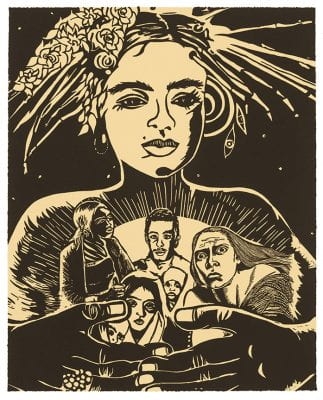“Sultana’s Dream,” a portfolio of 27 linocuts created by contemporary artist Chitra Ganesh and published by Durham Press, is on view at the Mandeville Gallery through June 20.
The project is inspired by “Sultana’s Dream,” an early 20th century sci-fi story by Rokeya Sakhawat Hossain, a Bengali feminist author and social reformer.
The prints – all black linocuts on tan paper, created in 2018 – illustrate elements of the text and use its imagery and themes to explore politically pressing current day topics.
Due to COVID-19 safety measures, viewing is limited to the campus community only.
Student docents Maymunah Ahmed ’23, Ryan Hayes ’23, Adenike Hickson ’22, Mallory Nelson ’22 and Samuel Perry ’23 will hold a virtual gallery talk April 15, 5-6 p.m., to discuss and interpret the artwork and themes in “Sultana’s Dream.”
The event is free and open to the public. A 360-degree virtual tour of the exhibition created by Nelson is available for viewing.
The artist states that her series of prints “draws on Hossain’s vibrant imagery, translating a narrative written in verse into a visual grammar that connects with problems shaping 21st century life.” These problems range from gender-based and economic inequalities to environmental disasters and ongoing geopolitical conflicts.
The short story that the art works are based on was first published in 1905 in The Indian Ladies’ Magazine and holds a singular position among early feminist science fiction. It features a narrator who is led on a stroll through a utopian matriarchy where women have harnessed the power of the sun to live prosperously and efficiently.
The galleries in the Nott Memorial are open to the campus community 9 a.m. to 5 p.m. daily. Access for current faculty, staff and students is via the building’s basement door with College ID card.
The art may also be viewed through the gallery’s online portal, which offers a magnification feature for close observation of individual pieces.
For more information, visit the Mandeville Gallery
